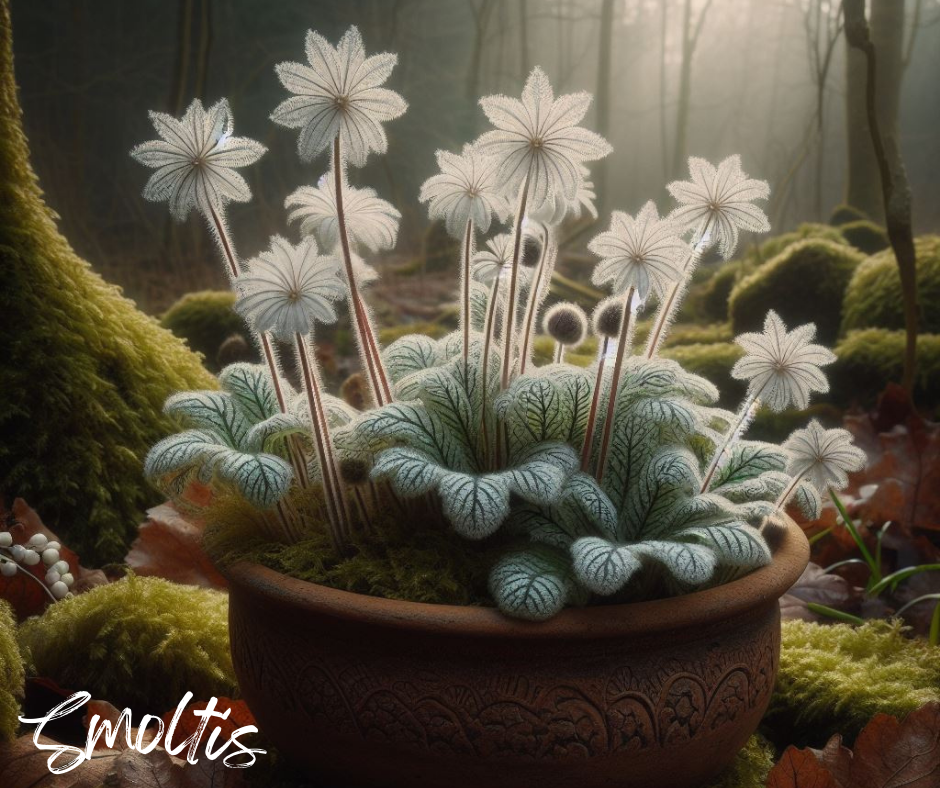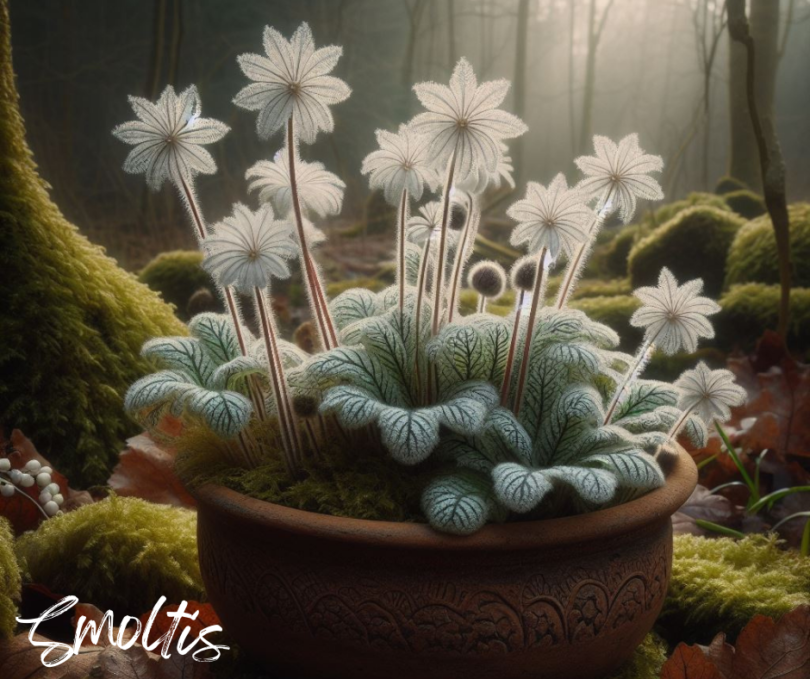Tiarellas, also known as foamflowers, are a captivating group of woodland plants that thrive in shaded, naturalistic garden settings. These delicate, whimsical flowers add enchanting beauty to the understories of forests, woodlands, and other shade-loving plant communities. With their intricate, lacy blooms and attractive foliage, tiarellas are a beloved choice for gardeners seeking to create lush, nature-inspired landscapes. This article explores the world of tiarellas, highlighting their cultural significance, horticultural requirements, and design applications within woodland gardens.

Key Takeaways
- Tiarellas, or foamflowers, are a captivating group of woodland plants that thrive in shaded, naturalistic garden settings.
- These delicate, whimsical flowers add enchanting beauty to the understories of forests, woodlands, and other shade-loving plant communities.
- Tiarellas are a beloved choice for gardeners seeking to create lush, nature-inspired landscapes.
- This article explores the cultural significance, horticultural requirements, and design applications of tiarellas within woodland gardens.
- Incorporating tiarellas and other native species can help create ecologically harmonious and sustainable woodland gardens.
Introducing Tiarellas: Woodland Whimsies
Tiarellas, members of the Saxifragaceae family, are charming perennial plants native to the woodland gardens of eastern North America. These diminutive, carpet-forming groundcovers are prized for their intricate, lace-like foliage and delicate, ethereal blooms that dance atop slender stalks.
Enchanting Foliage and Blooms
The deeply lobed, maple-like leaves of tiarellas often take on reddish or bronze hues in the fall, adding seasonal interest to the woodland garden. Tiarella’s small, clustered flowers resemble miniature foam, hence the common name “foamflower,” lending an enchanting, whimsical quality to these woodland wildflowers.
Versatile Groundcovers for Shady Spaces
These versatile plants thrive in the dappled shade of forest understories, making them ideal for creating textural tapestries and softening the edges of pathways or garden beds. Tiarellas are well-suited for naturalistic landscaping and ecological gardening efforts, as they seamlessly integrate with other shade-loving perennials and native plants found in woodland ecosystems.
Woodland Gardens: Nature’s Sanctuaries
Woodland gardens are cherished as serene, nature-inspired sanctuaries that celebrate the beauty of native plant communities. These shaded, naturalistic landscapes mimic the layered ecosystems of mature forests, featuring a diverse array of understory plants, shrubs, and canopy trees. Woodland gardens provide a peaceful retreat from the bustling world, inviting visitors to immerse themselves in the tranquil, verdant atmosphere.
By incorporating native species like tiarellas, gardeners can create lush, ecologically harmonious oases that support local wildlife and foster a sense of connection with the natural world. These woodland gardens serve as sanctuaries, where the beauty of shade gardens and the intricate balance of forest gardens come together in a harmonious celebration of naturalistic landscaping and ecological gardening.
Tiarella Species: A Diverse Palette
The genus Tiarella encompasses a captivating array of foamflower species, each with its own unique charm and characteristics. At the forefront is the Tiarella cordifolia, commonly known as the heartleaf foamflower, which features broad, lobed leaves and delicate white or pink-tinged blooms that dance atop slender stalks. Another notable variety is Tiarella wherryi, called Wherry’s foamflower, boasting deeply dissected, fern-like foliage and a more compact growth habit.
Tiarella cordifolia: The Heartleaf Foamflower
The heartleaf foamflower, Tiarella cordifolia, is a beloved member of the tiarella species. Its broad, heart-shaped leaves and delicate, lacy flowers make it a standout choice for woodland gardens and shade-loving perennial plantings. This native plant thrives in the dappled shade of forest understories, adding a touch of whimsy and enchantment to the woodland wildflowers that grace the landscape.
Tiarella wherryi: The Wherry’s Foamflower
Another captivating tiarella species is Tiarella wherryi, commonly known as Wherry’s foamflower. This cultivar boasts deeply dissected, fern-like foliage that creates a delicate, textural contrast to the more rounded leaves of its counterparts. Wherry’s foamflower also sports a more compact growth habit, making it a versatile choice for woodland gardens and native plant compositions.
Exploring Other Varieties
Beyond the well-known Tiarella cordifolia and Tiarella wherryi, gardeners can explore a diverse range of other tiarella species, each offering subtle variations in leaf shape, flower color, and plant size. This wealth of diversity allows gardeners to create visually dynamic and captivating woodland gardens that celebrate the beauty of native plants and shade-loving perennials.
Cultivation and Care
Tiarellas, with their enchanting woodland charm, thrive in the cool, moist, and well-draining soil conditions typical of their natural habitat. These tiarella cultivation enthusiasts prefer rich, humus-y soils that retain moisture but don’t become waterlogged. Regarding light requirements, tiarellas are adapted to the dappled shade found in forest understories, requiring partial to full shade for optimal growth and flowering.
Soil Preferences
The key to successful tiarella care lies in providing the right soil conditions. Tiarellas excel in rich, organic-rich soils that are well-draining yet retain sufficient moisture. These soil preferences mimic the nutrient-dense, humus-y forest floor where they naturally flourish.
Light Requirements
As woodland plants, tiarellas thrive in the filtered light of shaded environments. They require partial to full shade to achieve their best growth and flowering performance. Exposing tiarellas to direct sunlight can lead to stress and potential foliage damage.
Watering and Maintenance
While establishing, tiarellas may benefit from consistent watering to ensure their roots have ample moisture. However, once mature, these resilient plants are relatively drought-tolerant. Maintenance for tiarellas involves occasional deadheading of spent blooms and dividing overcrowded clumps every few years to rejuvenate the plants and encourage vigorous growth.
Designing with Tiarellas
Tiarellas shine when incorporated into naturalistic, woodland-inspired garden designs. Their delicate, lacy foliage and airy blooms complement a variety of shade-loving perennials, ferns, and shrubs, such as hostas, heucheras, and asarums. When grouped together, tiarellas form a captivating, low-growing groundcover that adds depth, texture, and visual interest to the understory.
Complementary Companions
Gardeners can further enhance the woodland aesthetic by combining tiarellas with other native species, such as wild ginger, Virginia bluebells, and Solomon’s seal, to create layered, ecologically harmonious plant communities. This strategic pairing of tiarella design with complementary companion plants helps to cultivate a cohesive, nature-inspired landscape that celebrates the beauty of the woodland garden.
Creating Textural Tapestries
The delicate, lacy foliage and airy blooms of tiarellas make them an ideal choice for adding textural interest to woodland garden designs. When planted in drifts or masses, tiarellas form a captivating groundcover that softens the edges of pathways and garden beds, creating a sense of depth and movement. This textural planting approach helps to evoke the natural, naturalistic aesthetic of the woodland environment, inviting visitors to immerse themselves in the lush, layered tapestry of the tiarella-centric design.
Woodland Gardens: Embracing Ecological Harmony
Woodland gardens embody the principles of ecological harmony, celebrating the diversity and interconnectedness of native plant communities. By incorporating tiarellas and other indigenous species, gardeners can recreate the natural balance and resilience found in mature forest ecosystems. This approach not only supports local wildlife, such as pollinators and small mammals, but also reduces the need for resource-intensive maintenance, making woodland gardens a more sustainable and environmentally responsible choice.
Native Plant Communities
When designing woodland gardens, the focus should be on cultivating native plant communities that thrive in the local environment. Tiarellas, as part of the woodland understory, can be seamlessly integrated with other native perennials, ferns, and shrubs to create a harmonious and biodiverse landscape. This not only enhances the visual appeal of the garden but also provides valuable habitat and food sources for native wildlife, contributing to the overall ecological health of the ecosystem.
Sustainable Gardening Practices
To ensure the long-term vitality of woodland gardens, gardeners should embrace sustainable gardening practices. This includes the use of organic soil amendments, minimizing the application of chemical fertilizers and pesticides, and avoiding the introduction of invasive species. By adopting these eco-friendly techniques, gardeners can reduce their environmental impact and create a more resilient and self-sustaining woodland oasis.
Through the incorporation of tiarellas and other native plants, as well as the implementation of sustainable gardening practices, woodland gardens can become shining examples of ecological harmony, fostering a deeper connection between people and the natural world.
Propagating Tiarellas
Tiarellas can be easily propagated through division or seed stratification, allowing gardeners to expand their woodland plantings and introduce new cultivars. This versatile approach to tiarella propagation ensures the long-term thriving of these captivating groundcovers in the shade garden.
Division Methods
One of the simplest ways to propagate tiarellas is through division. Gardeners can carefully split the rhizomatous root systems of mature plants in the spring or fall, creating new clumps that can be transplanted elsewhere in the woodland garden. This vegetative propagation technique allows for the rapid expansion of tiarella populations, making it an efficient method for gardeners seeking to establish or replenish their woodland plant propagation efforts.
Seed Stratification
For those interested in growing tiarellas from seed, the process often requires a period of cold seed stratification to break dormancy and encourage germination. By following the appropriate seed-starting protocols, gardeners can introduce new tiarella cultivars and add to the diversity of their woodland plantings. This seed-based approach offers the opportunity to experiment with different tiarella species and expand the range of these enchanting woodland plants within the garden.
Troubleshooting Common Issues
While tiarellas are generally low-maintenance and resilient plants, they may occasionally face some common challenges in the woodland garden. Tiarella problems like powdery mildew, leaf scorch, or slugs and snails can affect the health and appearance of the plants. Gardeners can address these troubleshooting issues through proactive monitoring, the application of organic fungicides or insecticidal soaps, and the implementation of cultural practices like improving air circulation and maintaining consistent soil moisture.
To manage pest management concerns, gardeners should regularly inspect their tiarella plantings for signs of damage or disease. Powdery mildew, a fungal infection that can cause discoloration and distortion of the leaves, can be treated with organic fungicides or by improving air flow around the plants. Similarly, leaf scorch, which can be caused by environmental factors like heat stress or irregular watering, can be mitigated by ensuring consistent soil moisture and providing shade or protection during periods of intense sunlight.
For disease control, gardeners may need to employ targeted measures to address slug and snail infestations, which can quickly consume the delicate foliage of tiarellas. The application of organic slug and snail baits, the creation of physical barriers, or the introduction of natural predators like birds or amphibians can help to manage these pests and protect the overall health of the tiarella plants.
By staying vigilant and addressing any issues promptly, gardeners can ensure the long-term thriving of their tiarella plantings, allowing these enchanting woodland wonders to continue to enchant and delight in the garden.
Tiarellas in Folklore and History
Tiarellas have a rich history and cultural significance, particularly among Native American communities. The heartleaf foamflower (Tiarella cordifolia) was used by the Cherokee and other Appalachian tribes for various medicinal and ceremonial purposes, such as treating skin conditions and respiratory ailments. The delicate, lace-like blooms of tiarellas have also inspired poetic and artistic expressions, with the plants often symbolizing fragility, grace, and the beauty of the natural world.
This cultural heritage and the deep-rooted connection between tiarellas and the woodland ecosystems they inhabit add to the allure and significance of these enchanting plants in the modern garden. As gardeners continue to embrace the tiarella folklore and tiarella history, these native plant uses and cultural significance will undoubtedly remain an integral part of the horticultural tapestry.
Conclusion
Tiarellas are captivating woodland plants that bring a sense of whimsy and enchantment to shaded garden settings. With their delicate blooms and attractive foliage, these versatile groundcovers are an excellent choice for creating lush, nature-inspired landscapes that celebrate the beauty of native plants. By incorporating tiarellas and other indigenous species into their woodland gardens, gardeners can cultivate ecologically harmonious oases that provide valuable habitat for local wildlife and foster a deeper connection with the natural world.
As gardeners continue to embrace the charm and cultural significance of tiarellas, these woodland wonders will undoubtedly remain a beloved and integral part of the horticultural tapestry. Whether used as captivating groundcover or incorporated into naturalistic landscaping designs, tiarellas offer a unique and enchanting addition to any ecological garden that celebrates the beauty and diversity of the natural world.
FAQ
What are tiarellas?
Tiarellas, also known as foamflowers, are a captivating group of woodland plants that thrive in shaded, naturalistic garden settings. These delicate, whimsical flowers add enchanting beauty to the understories of forests, woodlands, and other shade-loving plant communities.
What are the key features of tiarellas?
Tiarellas are prized for their intricate, lace-like foliage and delicate, ethereal blooms that dance atop slender stalks. The deeply lobed, maple-like leaves often take on reddish or bronze hues in the fall, adding seasonal interest to the woodland garden. Tiarella’s small, clustered flowers resemble miniature foam, hence the common name “foamflower.”
Where do tiarellas grow best?
Tiarellas thrive in the cool, moist, and well-draining soil conditions typical of woodland environments. They prefer partial to full shade for optimal growth and flowering.
How can tiarellas be propagated?
Tiarellas can be easily propagated through division or seed stratification. Division is a straightforward method, where gardeners can carefully split the rhizomatous root systems of mature plants. For those seeking to grow tiarellas from seed, the seeds often require a period of cold stratification to break dormancy and encourage germination.
What are some common issues with tiarellas?
While tiarellas are generally low-maintenance and resilient plants, they may occasionally face challenges like powdery mildew, leaf scorch, or slugs and snails. Gardeners can address these problems through proactive monitoring and the implementation of organic pest management and disease control methods.
What is the cultural significance of tiarellas?
Tiarellas have a rich history and cultural significance, particularly among Native American communities. The heartleaf foamflower (Tiarella cordifolia) was used by the Cherokee and other Appalachian tribes for various medicinal and ceremonial purposes, and the delicate, lace-like blooms have inspired poetic and artistic expressions.







